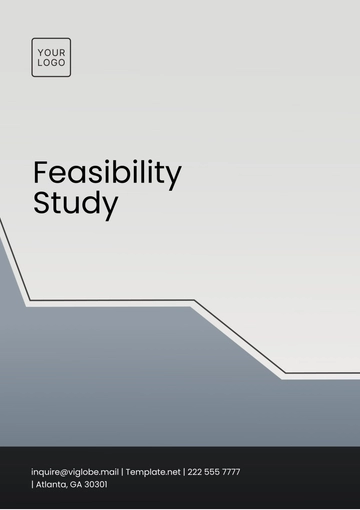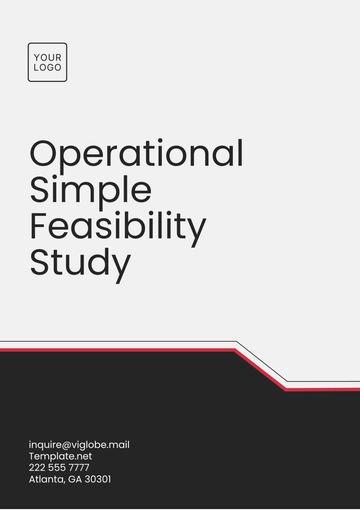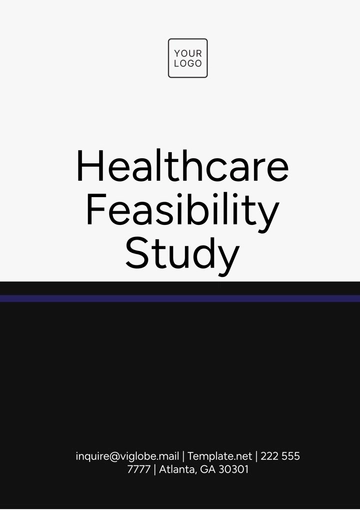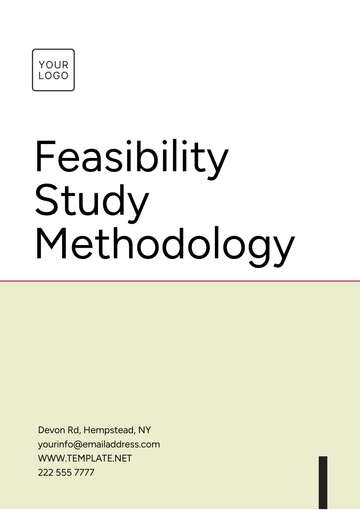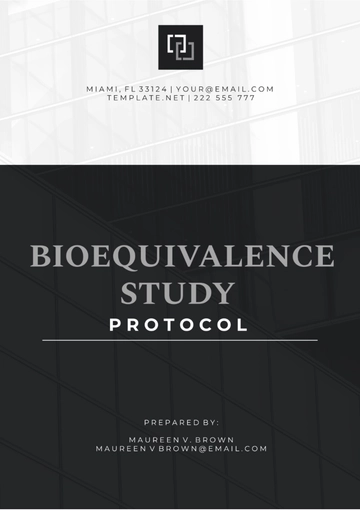Free Hazard Mitigation Feasibility Study

Executive Summary
The Hazard Mitigation Feasibility Study, conducted for [Your Company Name], serves as a comprehensive analysis of potential hazard mitigation measures. The purpose of this study is to provide a thorough assessment of various mitigation options and their feasibility. It is intended to guide decision-makers in developing strategies to enhance the resilience of [Your Company Name] against identified hazards.
A. Key Findings
Identification of critical hazards, including natural disasters such as earthquakes, floods, and wildfires, along with man-made hazards.
Evaluation of vulnerabilities within [Your Company Name] to these hazards.
In-depth analysis of hazard mitigation options, both structural and non-structural.
A cost-benefit analysis that considers the financial implications of each mitigation measure.
Feasibility assessments covering technical, economic, environmental, and social factors.
Identification of potential risks associated with mitigation measures and strategies for mitigation.
The Hazard Mitigation Feasibility Study aims to provide a clear roadmap for [Your Company Name] to implement effective hazard mitigation measures. The findings and recommendations presented in this study will aid in decision-making and planning for a more resilient future.
Introduction
A. Purpose of the Feasibility Study
The primary purpose of this Hazard Mitigation Feasibility Study is to assess the viability of implementing hazard mitigation measures to enhance the resilience of [Your Company Name]. It aims to provide a detailed understanding of the benefits and challenges associated with different mitigation options. By conducting this study, [Your Company Name] seeks to proactively address potential hazards and reduce their impact on operations, assets, and stakeholders.
B. Scope of the Study
The scope of this study encompasses several key components:
Hazard Identification: A comprehensive examination of identified hazards, including natural disasters and man-made events, that may affect [Your Company Name].
Vulnerability Assessment: An assessment of the vulnerabilities within [Your Company Name] to these hazards, identifying critical areas, assets, and processes.
Hazard Mitigation Options: An in-depth analysis of both structural and non-structural mitigation measures, evaluating their feasibility and effectiveness.
Cost-Benefit Analysis: A thorough assessment of the costs and benefits associated with each mitigation option.
Feasibility Assessment: Evaluation of the technical, economic, environmental, and social feasibility of mitigation measures.
Risk Assessment: Identification of potential risks and development of strategies to mitigate them.
Background and Context
A. Hazard Identification
The Hazard Mitigation Feasibility Study begins by identifying a range of hazards that could potentially impact [Your Company Name]. These hazards encompass both natural disasters, such as earthquakes, floods, and wildfires, and man-made hazards, including industrial accidents and infrastructure failures. Understanding the specific hazards is essential for developing effective mitigation strategies.
B. Vulnerability Assessment
A critical step in this study is the assessment of vulnerabilities within [Your Company Name] related to the identified hazards. This assessment involves evaluating the susceptibility of various assets, critical processes, and infrastructure to potential hazards. The vulnerability assessment helps pinpoint areas where mitigation efforts are most urgently needed.
Methodology
A. Data Collection
The methodology section outlines the systematic approach taken in conducting this Hazard Mitigation Feasibility Study. Data collection is a fundamental step, involving gathering historical hazard data, information about [Your Company Name]'s infrastructure, and socio-economic data relevant to the study. These data sources provide the foundation for the subsequent analysis.
B. Risk Assessment
A comprehensive risk assessment process is integral to this study. It quantifies the potential impact of hazards on [Your Company Name] and its stakeholders. This involves evaluating the probability of hazard events occurring and the potential consequences they may have on assets, operations, and personnel. The risk assessment is essential for informed decision-making and prioritizing mitigation measures.
C. Feasibility Analysis
The feasibility analysis is a pivotal component of this study, involving the evaluation of various mitigation options for their technical, economic, environmental, and social feasibility. This analysis is essential for determining the suitability of different mitigation measures within the context of [Your Company Name]'s operations and goals.
Cost-Benefit Analysis
A. Cost Estimation
In this section, we delve into the detailed cost estimation process for each hazard mitigation option under consideration. The cost estimation encompasses various components, including initial capital investment, ongoing operational and maintenance costs, and potential savings.
Initial Capital Investment: This includes the costs associated with the implementation of the selected mitigation measures. For example, if retrofitting is chosen as a structural mitigation option, we would calculate the expenses related to engineering and construction.
Ongoing Operational and Maintenance Costs: It is essential to assess the long-term financial commitment required to sustain the chosen mitigation measures. This includes expenses such as routine maintenance, monitoring systems, and personnel costs.
Potential Savings: Cost-benefit analysis also considers the potential cost savings resulting from hazard mitigation. This could include reduced damages to assets, lower insurance premiums, and decreased business interruption costs.
B. Benefit Assessment
The benefit assessment evaluates the advantages and positive outcomes associated with each hazard mitigation option. These benefits extend beyond mere cost savings and encompass broader considerations:
Damage Reduction: The primary benefit of hazard mitigation is a reduction in potential damage caused by hazards. This can include protecting physical assets, preserving critical infrastructure, and minimizing disruption to operations.
Increased Resilience: Implementing mitigation measures can enhance [Your Company Name]'s resilience, allowing it to maintain essential functions even in the face of adverse events. Enhanced resilience can lead to faster recovery and reduced downtime.
Societal Benefits: Beyond the organization, there can be societal benefits. These may include increased safety for employees and the surrounding community, as well as reduced burden on emergency response systems.
The cost-benefit analysis assists decision-makers in understanding the financial implications of each mitigation option and its potential positive impacts on [Your Company Name] and its stakeholders.
Feasibility Assessment
A. Technical Feasibility
Technical feasibility examines the practical aspects of implementing each mitigation measure. It assesses whether the necessary technology, skills, and resources are available or can be acquired. For example, if the selected option involves advanced technology, this section will evaluate the organization's technical capabilities and any potential challenges.
B. Economic Feasibility
Economic feasibility is a critical factor in determining the viability of mitigation options. It involves a detailed analysis of costs and benefits. If the costs outweigh the benefits significantly, it may not be economically feasible to pursue a particular mitigation measure. This section quantifies the financial aspects of each option and considers factors like return on investment and payback period.
C. Environmental Feasibility
Environmental feasibility evaluates the impact of mitigation measures on the environment. It ensures that selected options comply with environmental regulations and sustainability goals. This assessment includes considerations of ecological impact, resource usage, and adherence to relevant environmental standards.
D. Social Feasibility
Social feasibility assesses the acceptability of mitigation measures within the community and among stakeholders. It considers factors such as public perception, stakeholder engagement, and potential social resistance. Understanding and addressing social concerns are crucial for the successful implementation of hazard mitigation measures.
Risk Assessment
A. Identification of Risks
Identifying potential risks associated with the implementation of hazard mitigation measures is a critical aspect of this study. Risk identification involves a systematic analysis of factors that could lead to the failure or suboptimal performance of chosen mitigation options. Some common risks include:
Technical Risks: These risks relate to the feasibility of implementing chosen measures from a technical standpoint. This could involve issues with the technology used or unforeseen technical challenges during implementation.
Economic Risks: Economic risks involve factors that could affect the financial viability of the mitigation measures. Economic uncertainties, cost overruns, and unexpected financial challenges are considered in this assessment.
Environmental Risks: Environmental risks pertain to the potential impact of mitigation measures on the environment. This includes ecological disruptions, regulatory issues, and sustainability concerns.
Social Risks: Social risks encompass factors related to public acceptance, stakeholder resistance, and community concerns regarding the chosen mitigation options.
B. Risk Mitigation Strategies
To mitigate the identified risks, this section outlines strategies and contingency plans. Each risk is addressed with specific measures to minimize its potential impact:
Risk Monitoring and Management: Implementing a robust risk management plan to continuously monitor and address risks as they arise throughout the mitigation process.
Technical Risk Mitigation: Detailing strategies to address technical challenges, including alternative technical solutions, expert consultations, and thorough testing and validation.
Economic Risk Mitigation: Establishing financial controls, contingency budgets, and cost-tracking mechanisms to mitigate economic risks.
Environmental Risk Mitigation: Ensuring compliance with environmental regulations, conducting environmental impact assessments, and implementing eco-friendly technologies or practices.
Social Risk Mitigation: Engaging with stakeholders, conducting public awareness campaigns, and addressing community concerns through open communication and transparency.
Recommendations
A. Preferred Mitigation Option
Based on the comprehensive analysis conducted in previous sections, this subsection presents the recommended hazard mitigation option. The recommendation takes into account technical feasibility, economic viability, environmental considerations, and social acceptability. It is the culmination of an extensive evaluation process and represents the best course of action to enhance the resilience of [Your Company Name].
B. Implementation Plan
This subsection outlines a detailed implementation plan for the selected hazard mitigation option. It includes:
Timeline: A timeline for the implementation, specifying key milestones and deadlines.
Resource Allocation: Allocation of resources, including budgeting, personnel, and technology requirements.
Responsibilities: Identification of key individuals or teams responsible for executing and overseeing the implementation.
Monitoring and Evaluation: Establishing a system for continuous monitoring and evaluation of the mitigation measures' progress and effectiveness.
Contingency Planning: Developing contingency plans to address unforeseen challenges or risks that may arise during implementation.
Communication Strategy: Detailing a communication strategy to keep stakeholders informed and engaged throughout the process.
Conclusion
The Hazard Mitigation Feasibility Study conducted for [Your Company Name] has been a comprehensive exploration of potential hazard mitigation measures. Through a systematic evaluation of various aspects, including hazard identification, vulnerability assessment, cost-benefit analysis, feasibility assessment, risk assessment, and recommendations, key findings and insights have emerged.
A. Recommendation
Based on the extensive analysis conducted, a preferred hazard mitigation option has been identified. This recommendation considers technical feasibility, economic viability, environmental sustainability, and social acceptability. The selected mitigation option represents the most suitable approach for [Your Company Name] to enhance its resilience and minimize the impact of hazards.
B. Implementation Plan
An implementation plan has been developed, outlining a structured approach to execute the selected mitigation measures. This plan includes timelines, resource allocation, responsibilities, monitoring and evaluation mechanisms, and contingency planning. It provides a clear roadmap for [Your Company Name] to follow during the implementation phase.
- 100% Customizable, free editor
- Access 1 Million+ Templates, photo’s & graphics
- Download or share as a template
- Click and replace photos, graphics, text, backgrounds
- Resize, crop, AI write & more
- Access advanced editor
Explore hazard mitigation possibilities with Template.net's Hazard Mitigation Feasibility Study Template. This editable and customizable tool, powered by our Ai Editor Tool, allows thorough examination of potential hazards and the feasibility of mitigation strategies. Empower your team to make informed decisions and enhance workplace safety with this comprehensive solution from Template.net.



